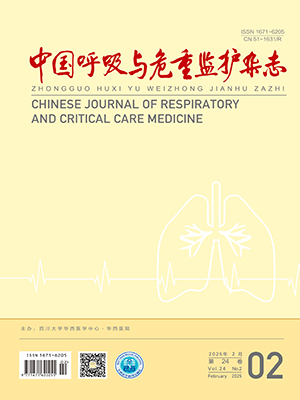| 1. |
慢性阻塞性肺疾病急性加重(AECOPD)诊治专家组.慢性阻塞性肺疾病急性加重(AECOPD)诊治中国专家共识(2014年修订版).国际呼吸杂志,2014,34:1-11.
|
| 2. |
Barbera JA,Roca J,Ferrer A,et al.Mechanisms of worsening gas exchange during acute exacerbations of chronic obstructive pulmonary disease.Eur Respir J,1997,10:1285-1291.
|
| 3. |
Diaz O,Iglesia R,Ferrer M,et al.Effects of noninvasive ventilation on pulmonary gas exchange and hemodynamics during acute hypercapnic exacerbations of chronic obstructive pulmonary disease.Am J Respir Crit Care Med,1997,156:1840-1845.
|
| 4. |
Hill NS.Noninvasive ventilation for chronic obstructive pulmonary disease.Respir Care,2004,49:72-87;discussion 87-79.
|
| 5. |
Crossley DJ,McGuire GP,Barrow PM,et al.Influence of inspired oxygen concentration on deadspace,respiratory drive,and PaCO2 in intubated patients with chronic obstructive pulmonary disease.Crit Care Med,1997,25:1522-1526.
|
| 6. |
Pauwels RA,Buist AS,Calverley PM,et al.Global strategy for the diagnosis,management,and prevention of chronic obstructive pulmonary disease.Am J Respir Crit Care Med,2014,163:1256-1276.
|
| 7. |
Cano NJ,Pichard C,Court-Fortune I,et al.Survival of patients with chronic respiratory failure on long-term oxygen therapy and or non-invasive ventilation at home.Clin Nutr,2015,34:739-744.
|
| 8. |
Bone RC.Treatment of respiratory failure due to advanced chronic obstructive lung disease.Arch Intern Med,1980,140:1018-1021.
|
| 9. |
DeGaute JP,Domenighetti G,Naeije R,et al.Oxygen delivery in acute exacerbation of chronic obstructive pulmonary disease.Effects of controlled oxygen therapy.Am Rev Respir Dis,1981,124:26-30.
|
| 10. |
Savi A,Gasparetto Maccari J,Frederico Tonietto T,et al.Influence of FIO2 on PaCO2 during noninvasive ventilation in patients with COPD.Respir Care,2014,59:383-387.
|
| 11. |
Sassoon CS,Hassell KT,Mahutte CK.Hyperoxic-induced hypercapnia in stable chronic obstructive pulmonary disease.Am Rev Respir Dis,1987,135:907-911.
|
| 12. |
Aubier M,Murciano D,Milic-Emili J,et al.Effects of the administration of O2 on ventilation and blood gases in patients with chronic obstructive pulmonary disease during acute respiratory failure.Am Rev Respir Dis,1980,122:747-754.
|
| 13. |
Dick CR,Liu Z,Sassoon CS,et al.O2-induced change in ventilation and ventilatory drive in COPD.Am J Respir Crit Care Med,1997,155:609-614.
|
| 14. |
Hanson CW 3rd,Marshall BE,Frasch HF,et al.Causes of hypercarbia with oxygen therapy in patients with chronic obstructive pulmonary disease.Crit Care Med,1996,24:23-28.
|
| 15. |
Scano G,Spinelli A,Duranti R,et al.Carbon dioxide responsiveness in COPD patients with and without chronic hypercapnia.Eur Respir J,1995,8:78-85.
|




